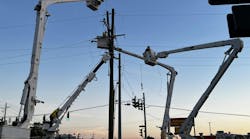I’m sitting in my office writing this month’s column, and it’s snowing outside. The wind is howling, and the temperature is dropping. Some parts of town are reporting whiteout conditions It’s not a good day to be out and about, but it’s a great day for being in my home office with a hot cup of coffee.
As the morning progressed, local officials sent out several public service announcements saying the schools had switched to remote learning. They also recommended everybody stay home and work remotely. That got me thinking about how far our digital workplace technology has advanced, and what’s next.
When 2020 began, offsite working was uncommon for most of the workforce, but the pandemic shutdown changed that quickly. Suddenly there was a technological stampede to get remote offices set up. The technology was available, but the scale of the situation caused hardware and software shortages. That resulted in shortcuts and temporary solutions.
Mobile Devices
By the start of 2021 the digital office was functioning, but there were problems. The rapid acceleration to setup our digital workplace left rough edges that needed polishing to improve its efficiency. Without realizing it, I got myself caught up with hardware issues like everyone else. I had been adding new devices to my office without considering what it was doing to my network.
It turned out my router was several generations past its prime, and it impacting my internet connectivity. This wasn’t uncommon and lot of us had to update our electronics, but there was another issue. Our connectivity relies on fragile mobile devices (i.e., smartphones, tablets, and laptops). According to several surveys the leading causes of damage to these breakable devices is dropping them and/or spilling liquids on them.
Fixing them is almost impossible, so we replace them with similar devices. This has resulted in a growing interest in more sturdy mobile devices that can withstand being hammered or soaked. Today’s users can buy a device that meets IEC’s IP (Ingress Protection) ratings for better protection. An IP rating of IP00 means there’s no protection at all. An IP68 rating can be submerged in a meter of water. Most available devices fit somewhere in between, so be careful.
When it comes to extreme conditions, it gets a whole lot more complicated. The average smartphone, tablet, or laptop is more of a recreational device than being road-warrior worthy and need to be handled carefully. They have a real problem being dropped, pounded, or banged around. For demanding environments, you need rugged equipment and that is why ruggedized mobile devices are attracting attention.
Mil Standards
I talked with Chad Hall, strategic account manager of Utility & Enterprise Mobility Solutions for Panasonic System Solutions Company of North America about this ruggedized technology and received some significant insights. He told me Panasonic celebrated the 25th anniversary of the “TOUGHBOOK” brand last year. These ruggedized laptops and tablets are characterized as being either semi-rugged or fully rugged when it comes to handling extreme conditions.
I found out all fully rugged devices meets all military standards (i.e.,MIL-STD-810) along with the toughest IP and NEMA standards. Fully ruggedized laptops and tablets can likely survive just about any extreme environments that utility personnel encounter in their demanding jobs. When I was building substations I saw a Panasonic “TOUGHBOOK” fall from a bucket truck. It bounced, and was still working when we retrieved it. It wasn’t a case of carelessness. It’s just that things happen in the field, which is why ruggedized mobile devices are becoming popular on the grid.
Semi-rugged devices like Panasonic’s “TOUGHBOOK 55” is a good example. It’s a laptop that is able to withstand rough conditions that utility personnel run into more often than extreme environments. Typically semi-rugged devices have spill proof keyboards, magnesium housings and shock mounted hard disks for drop and shock protection. They also can handle a wide range of low and high temperatures, but not the extremes a fully ruggedized device can.
While we’re on the subject, there are also a number of smartphones on the market that meet all of the same stringent requirements and fall into the same categories of fully and semi-ruggedized. These sturdy phones are not fashionable, but they are rugged. Whatever your needs are make sure you look into all the device’s features and the specifications that make them tough. Ask lots of questions and hopefully the device you pick will last a long time in the field.


